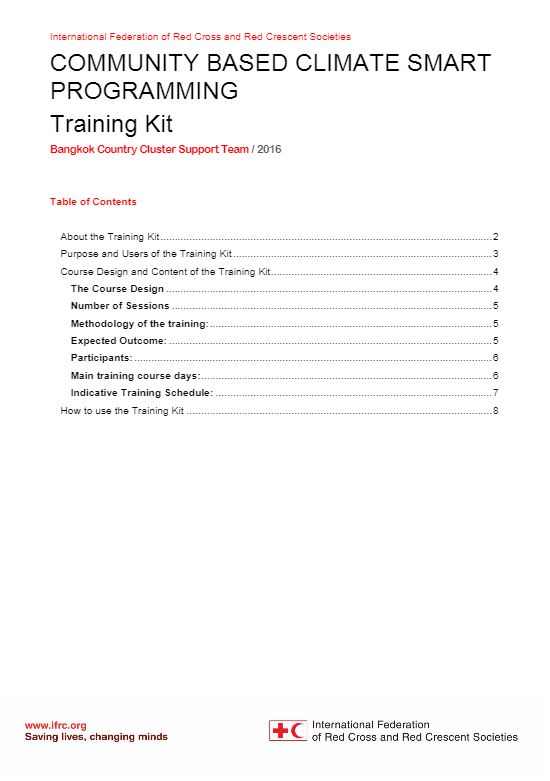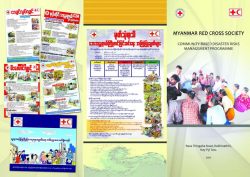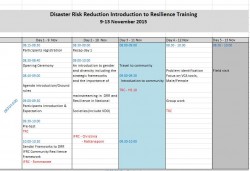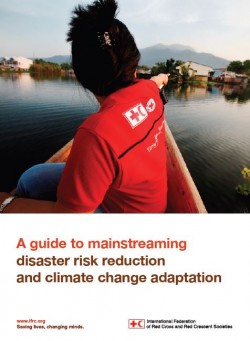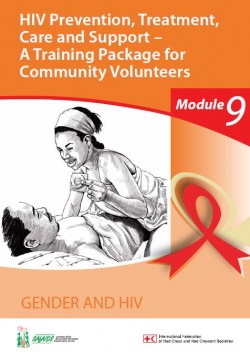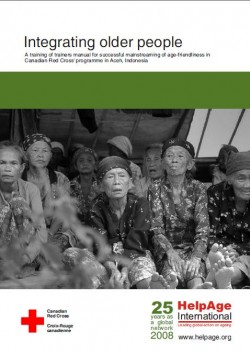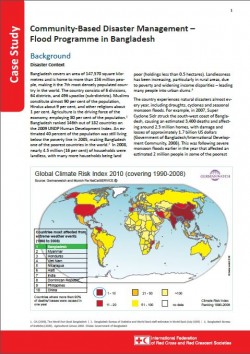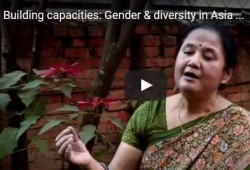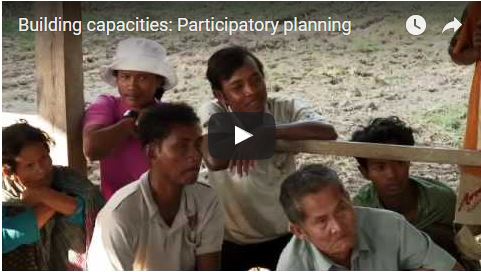Community-Based Disaster Risk Management (CBDRM) Brochure in English and Burmese
Purpose: Conduct advocacy sessions for local authorities and Red Cross branch to ensure their participation in implementation and support for sustainability.
Overview: Review disaster profiles, vulnerabilities, capacities of most vulnerable Village – Communities.
Usage: Training.
Audience: Volunteers.
![]()
Introduction to Resilience workshop Thailand from 9 – 13 November 2015
Purpose:
Overview:
Usage: Training
Audience: National Society leadership, Technical staff, Communication staff
For related documents, click here:
- Day 1:
- Day 2
- IFRC Framework for Community Resilience (2014)
- Minimum standard commitments to gender and diversity in emergency programming – pilot version (IFRC 2015)
- Handbook for a School-based Risk Reduction Initiative (IFRC, 2015)
- Resilience Infographic:
![]()
A Guide to Mainstreaming Disaster Risk Reduction and Climate Change Adaptation
Purpose:
This guide has been developed to support Red Cross and Red Crescent Societies and IFRC staff in more systematically integrating risk reduction measures into their planning. It describes in detail what key issues need to be considered, and when. The guidance aims at ensuring that risk reduction measures are taken into account in different sectors and contexts. It also details the key elements that need to be in place to create an enabling environment.
Overview:
- General steps for mainstreaming disaster risk reduction (DRR) and climate change adaptation (CCA) are: DRR and CCA screening. The strategy, policy, programme or project in question must be first screened with a DRR and CCA lens, and then a detailed assessment made. If this shows that disaster and climate change risks have not been duly considered or addressed, then adjustments should be made to the planned activity. A monitoring and evaluation (M&E) framework should also be developed. Mainstreaming DRR and CCA can be ensured only when the process is regularly monitored and evaluated.
- The paper details six specific programming contexts (conflict, urban, reducing vulnerability, strengthening resilience, disaster preparedness, disaster response, and recovery) and key sectors (health and care; water, sanitation and hygiene; migration; shelter and settlement; livelihood and food security; natural resource management) for mainstreaming DRR and CCA. Each of these is accompanied by specific key principles of DRR and CCA mainstreaming, as well as good practice checklists. Aside from the context-specific guidance, there are two general principles: first, a National Society needs to ensure that it has adequate capacity at relevant levels to mainstream DRR and CCA; second, given that risk patterns change, risk should be monitored at least once per year. If changes in circumstances and risk are identified, programming choices and activities may need to be adapted to these changes.
- A gender good practice checklist can be found on p.52.
Usage: Guidance for project implementation
Audiences: Technical staff
Reference: International Federation of Red Cross and Red Crescent Societies (2013). A Guide to Mainstreaming Disaster Risk Reduction and Climate Change Adaptation (pp. 1-62).
![]()
HIV Prevention, Treatment, Care and Support (A Training Package for Community Volunteers)
Purpose
This document provides guidelines to volunteers on the following issues: what is gender; gender and HIV; gender and HIV prevention; gender and HIV treatment; and the role of gender in care and support.
Overview
The purpose of session one is to ensure that community based volunteers (CBVs) are able to define gender and understand the role that gender plays in the lives of men, women, girls and boys in their community.
Session two seeks to understand how gender and HIV are related and explore how gender inequalities, gender-based violence (GBV) and sexual and reproductive health rights (SRHR) are linked to HIV.
Session three explores the ways in which gender influences the vulnerability of women, men, girls and boys to HIV infection/re-infection and the role of CBVs in providing information and support.
Session four builds knowledge and skills to understand how gender influences the ability of people to access, prepare for and adhere to antiretroviral therapy (ART) and the role of CBVs in providing gender-responsive support.
The purpose of session five is to provide participants with the knowledge and skills to understand how gender influences the ability of CBVs to provide care for others and to care for themselves.
Usage: Guidance for project implementation, Training
Audiences: Volunteers; Gender and diversity practitioners
![]()
Integrating older people: A training of trainers manual for successful mainstreaming of age friendliness in Canadian Red Cross’ programme in Aceh, Indonesia
Purpose
This manual serves to equip the Canadian Red Cross team with the knowledge and tools to act as trainers for their partners and community-based organisations/associations/committees constituted as part of their programme.
The manual has six units which are to be treated as sessions. The lessons in each unit are sub-sessions, and where required each lesson is further divided into topics.
Overview
A trainer’s guide containing guidelines on how to deliver training can be found on p.6 of the document.
- Unit 1 provides a broad overview of ageing at global and national levels and helps to get an insight into the need for mainstreaming age friendliness.
- Unit 2 focuses on mobilising older people of the community.
- Unit 3 lists a few means to understand the vulnerabilities of older people and also to tap into their capacities so that they can contribute to the overall welfare of the community.
- Unit 4 provides a detailed overview of the different dynamics that affect older people in disasters.
- Unit 5 focuses on the various dynamics associated with older women and older people with disabilities.
- Unit 6 provides tools to assess age friendliness of a project, older people’s involvement in community based-organisations, capturing impact on older people, and tips to include older people in impact-monitoring and/or an evaluation process.
Usage: Guidance for project implementation, Training
Audiences: Technical staff; Gender and diversity practitioners
Reference: Canadian Red Cross, HelpAge International. Integrating older people: A training of trainers manual for successful mainstreaming of age friendliness in Canadian Red Cross’ programme in Aceh, Indonesia. . Pp. 1-96.
![]()
Community-Based Disaster Management – Flood Programme in Bangladesh
Purpose
This paper looks at the Community-Based Disaster Management Flood and Earthquake Preparedness and Response Programme (CBDM) implemented by the Bangladesh Red Crescent Society (BDRCS) in early 2005. The paper provides an overview of the programme, its outcomes, lessons learned from the programme and the way forward.
Overview
- The CBDM programme aimed to reach 31,000 families from 80 communities in 10 flood-prone districts (Lalmonirhat, Kuirgram, Tangail, Sirajgonj, Jamalpur, Munshigonj, Chandpur, Faridpur, Madaripur and Shariatpur).
- The goal of the programme was to reduce the vulnerability of people, particularly women, to disasters. It enhanced and sustained the capacity of high-risk communities to mitigate the impact of emergencies, particularly in flood and earthquake-prone areas of Bangladesh. The programme ensured that gender considerations were included at each stage, from design, assessments, implementation and monitoring and evaluation.
- The programme contributed to the timely and effective response of the BDRCS to the floods in 2008. It also made women in participating communities more enthusiastic about becoming volunteers. The recruitment of equal numbers of male and female volunteers and the promotion of more women into leadership and decision-making roles made significant contributions to increasing women’s access to the opportunities and benefits available through the CBDM programme, as well as ensuring their views and needs were incorporated into planning. Finally, the programme led to women becoming more financially solvent and more confident.
Usage: Learning from experience
Audiences: Technical staff
![]()
Audio Visual: Building Capacities – Gender & Diversity in Asia Pacific
Purpose
This video is one of five documentaries created to illustrate best practice in building community and Red Cross and Red Crescent capacity in a variety of cultural contexts in Mongolia, Australia, Nepal and Cambodia.
Overview
- The capacity-building process involves communities identifying their needs, volunteers offering their time, staff coordinating resources, and domestic and international partners providing support where necessary. It ultimately helps the vulnerable better manage their lives, reduce the risks they face and improve their long-term health, well-being and livelihoods.
- In Mongolia the Red Cross strives to ensure that the voices of groups such as the elderly, disabled and women-headed households, which will usually not be heard, are included in planning and branch activities.
- In Nepal, involvement with Red Cross programmes have improved the lives of Nepalese women, especially in terms of challenges faced by them in the community, which limit their participation in discussions about decisions affecting them.
- Many Cambodians have experienced social isolation, exclusion or discrimination in different forms as victims of the AIDS virus, war or sexual assault. The Red Cross empowers such people as volunteers to achieve new and appreciated roles in their communities.
- In Australia, the Red Cross has increased its attention to the needs of groups who have been marginalised socially, economically and culturally.
Usage: Training; Guidance for project implementation
Audiences: Volunteers, youth, technical staff
![]()
Audio Visual: Building Capacities – Participatory Planning
Purpose
This video is one of five documentaries created to illustrate best practices in building community and Red Cross and Red Crescent capacity in a variety of cultural contexts from Mongolia, Australia, Nepal and Cambodia.
Overview
- To start a participatory planning process a local Red Cross/Red Crescent branch should organise a discussion with vulnerable groups. This should include local government and other organisations that can meet some of the needs of the people. From these discussions come ideas for services, offers for community help such as volunteers and locally raised funds. Once a programme is designed and implemented with community participation, the community should give regular feedback to the Red Cross/Red Crescent to ensure that the service meets their needs or to suggest how it could be improved.
- In deciding its role to support the supply of clean drinking water, and other basic schemes, the Nepal Red Cross ensured that it closely consulted affected communities.
- In Cambodia, where flood, drought, storm and fire are the most frequent natural disasters, the Red Cross uses participatory planning with communities affected by regular disasters to strengthen community capacities.
- The Red Cross in Mongolia set up volunteer councils as a new way to listen to the needs of specific groups of people such as the youth, elderly and disabled.
- In Australia the Red Cross decided to find ways to work with young people, to understand better their needs and vulnerabilities.
Usage: Guidance for project implementation, Training
Audiences: Volunteers; Youth
The video could be accessed from https://www.youtube.com/watch?v=2Bft-_gKvt8
![]()



